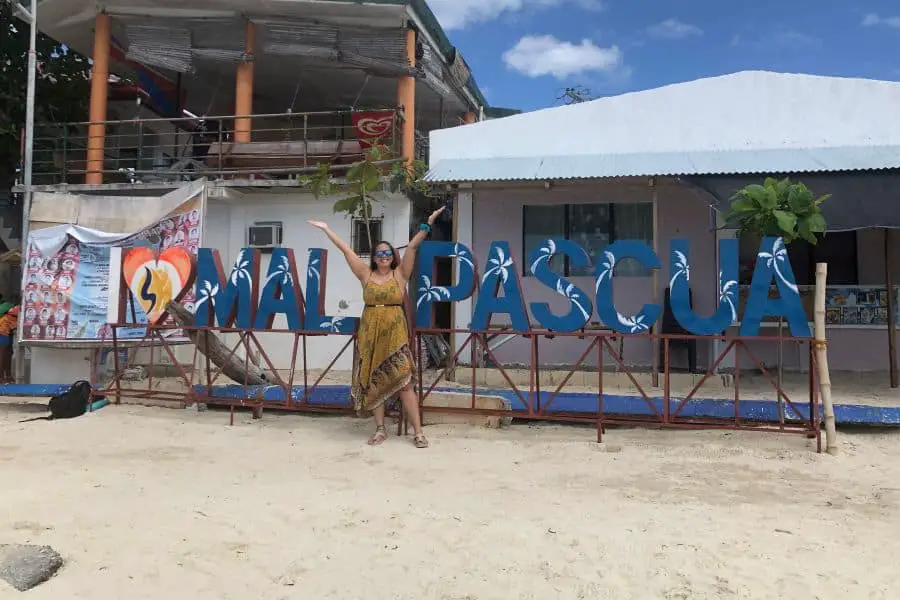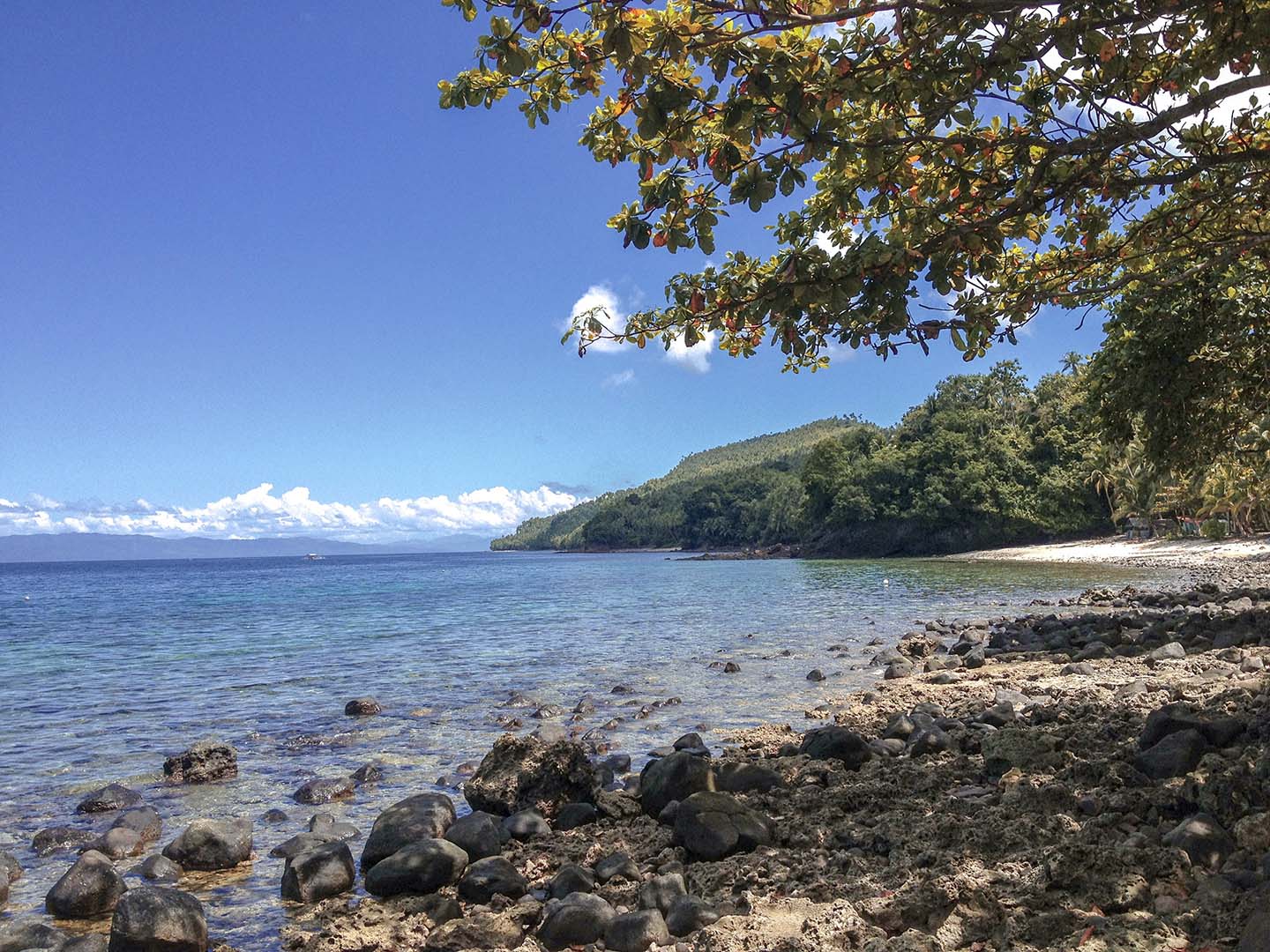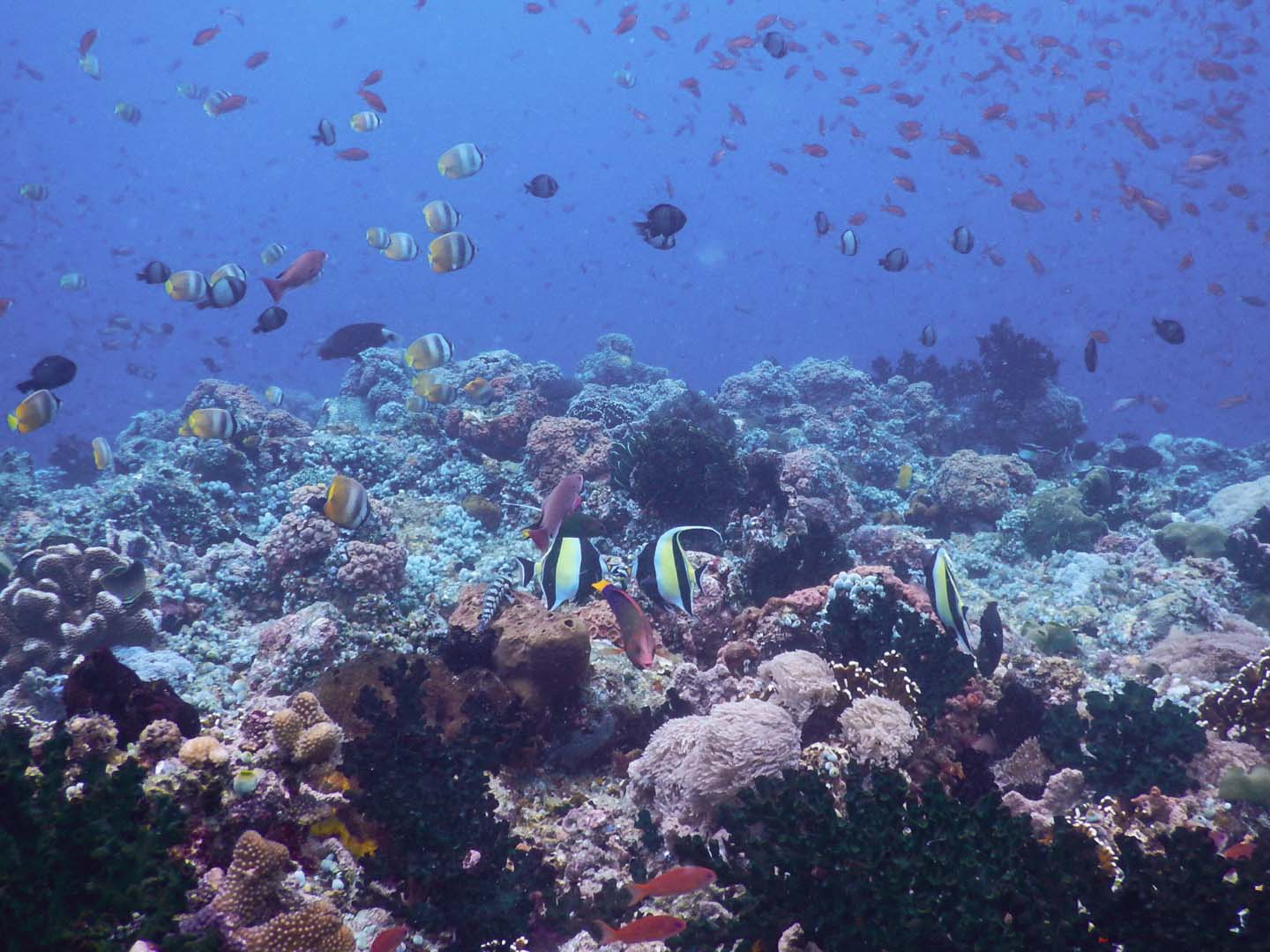Malapascua Island is well-known for its world-class diving opportunities, and it is home to some of the world’s most magnificent dive sites. This tropical paradise in the Philippines provides a one-of-a-kind underwater experience that is unparalleled.
As a seasoned diver, I can confidently state that Malapascua Island is one of the best dive spots in the Philippines. I have traveled to this remote island twice and each visit is just as memorable as the next.
On Malapascua Island, diving with thresher sharks is widely regarded as one of the most exhilarating types of diving. Only a select few locations around the globe allow scuba divers the opportunity to observe these wondrous animals up close and personal. If you go to Malapascua, there’s a high probability of seeing this shark with distinctively long tails.
While thresher sharks may be the biggest attraction in Malapascua, the island has so much more to offer.
Malapascua Island’s stunning coral reefs are teeming with vibrant fish, sea turtles, eels, and more. If you love finding tiny creatures, like nudibranchs, pygmy seahorses, crabs and shrimps, you will enjoy critter hunting in Malapascua. Dona Marilyn, which sank in 1988, is also a favorite among those who love wreck diving.
But that’s not all; Gato Island, located just off the coast of Malapascua Island, is also a must-see for divers. This island is home to a plethora of underwater caverns and tunnels, as well as a wide array of marine species, including white-tip reef sharks, sea snakes, and cephalopods.
In this post, I will share my experience with Malapascua diving. Continue reading if you wish to learn more about the best dive sites, the amazing marine life, and how to have a safe and pleasurable diving experience.
About Malapascua
Situated in the northern region of Cebu Province in the Philippines, Malapascua island is a must-visit destination for travelers seeking a serene and tranquil getaway. Located north of Cebu Island, within the municipality of Daanbantayan, this charming destination is nestled in the Visayas Sea.
This picturesque island spans 2.5 kilometers in length and 1 kilometer in width, offering ample opportunities for travelers to explore its natural beauty on foot.
According to local lore, during the 17th century, Spanish seafarers found themselves marooned on the island on Christmas Day because of a terrible storm. The island was deemed inhospitable by sailors who dubbed called it “Malas sa Pasko” which translates to “unfortunate Christmas.”. Thus, the name, Malapascua.
The island has a long fishing history, and many locals still rely on this trade for a living. The island’s economy has expanded to include tourism, with visitors’ favorite activities including diving, snorkeling, and island hopping.
Despite the influx of tourists, Malapascua Island has managed to retain its natural beauty and tranquility, making it a popular destination for travelers from around the world.
Dive Sites and Marine Life in Malapascua
Here are some of the dive spots in Malapascua that I recommend you visit.
1. Monad Shoal
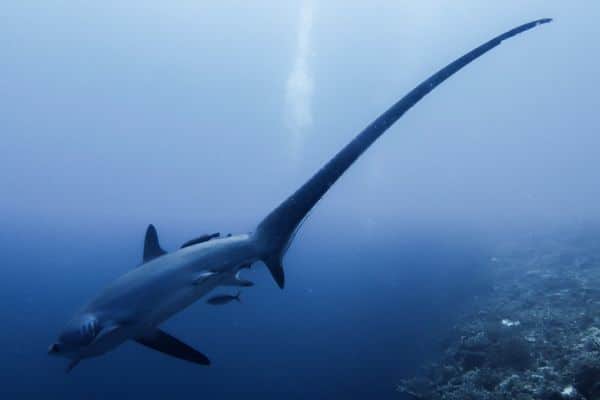
When scuba diving in Malapascua Island, a trip to the Monad Shoal dive site is an absolute necessity. This underwater plateau is famous for its early morning dives, which provide divers with the opportunity to spot the elusive thresher sharks.
The dive at Monad Shoal at dawn is by far the most well-liked excursion that Malapascua has to offer its guests. Since thresher sharks are most frequently spotted at a depth of approximately 20 to 25 meters, this site is ideal for divers with intermediate to advanced skill levels.
The shoal drops off to 200 meters so technical divers can also to participate in deep 30 and 100 meter dives where they have a chance of coming across thresher sharks.
Manta rays have also been spotted on this dive site in Malapascua. Like thresher sharks, the mantas use the shoal as a cleaning station.
It is interesting to note that there was a sudden drop in the number of thresher sharks seen at Monad Shoal a few months ago. On the other hand, bull sharks and tiger sharks are spotted more frequently in this dive site. It is speculated that the presence of these larger sharks in Monad Shoal have caused a decline in thresher shark sightings in this dive site.
Thresher Shark Diving in Malapascua, Cebu: Ultimate Guide 2023
2. Kimud Shoal
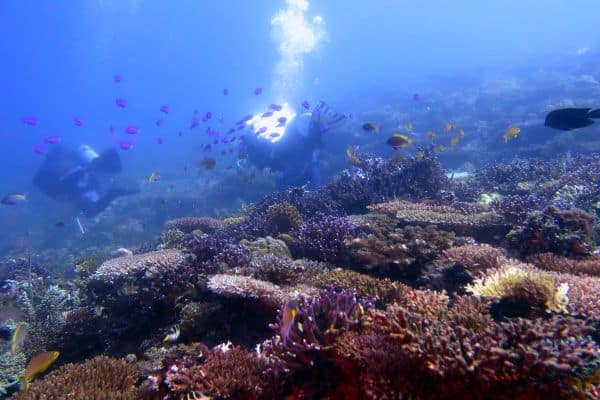
Kimud Shoal is another exciting dive site in Malapascua that offers a similar experience to Monad Shoal. However, it is shallower and further away from Malapascua Island. The top of the island lies at 12-16 meters, and the steep sides drop off to over 160 meters, making it an excellent site for both beginner and advanced divers.
Located near Monad Shoal and in the same trench, Kimud Shoal offers the opportunity to see thresher sharks and devil rays. Unlike in the past when thresher sharks were most commonly seen at dawn, they are now being spotted through out the morning.
Kimud Shoal is also known for schooling hammerhead sharks. But sadly, their numbers have dwindled in recent years, making sightings rare. There are still chances to spot them occasionally, especially from December to May.
Apart from the sharks, Kimud Shoal also boasts a diverse range of marine life. The top of the island is covered in hard coral, which provides excellent hiding spots for colorful reef fish species. The sides are covered in soft coral growth, and many species of shrimp, crabs and nudibranchs can be found among the corals.
3. Gato Island
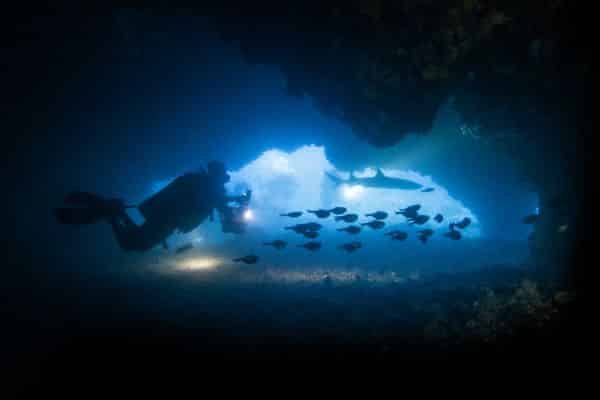
Gato Island is another popular Malapascua dive site that provides a unique experience for scuba divers.
Here you will will encounter many cave dwellers such as corals, crabs, lobsters, cardinal fish, sweepers, and possibly bamboo shark. The sighting of white-tip sharks, however, is the highlight of the tunnel. They are often found sleeping in the tunnel which makes it an even more thrilling experience.
Gato Island is a sanctuary and protected breeding location for the beautiful sea krait so it is common to see them here.The island is teeming with marine life, including nudibranchs, harlequin ghost pipefish, pygmy seahorses, frogfish, and other macro surprises.
Gato Island can be difficult for photographers because there is so much to see and photograph. Divers are frequently torn between using a macro lens or a wide-angle lens while diving in Gato Island.
Gato Island Diving: Exploring a Different Side of Malapascua
4. Deep Slope
Deep Slope dive site in Malapascua with an interesting topography which can be described as a sand dune that slowly turns into a small wall.
It’s not uncommon to spot garden eels on every dive, and if you’re lucky, you may even catch a glimpse of pygmy seahorses hiding among the sea fans. The sandy bottom is also home to cool creatures like the flamboyant cuttlefish, nudibranchs, pipefish, frogfish, and cowfish.
The small wall is covered in sponges, soft coral and hard corals. It has nooks and crannies where creatures such as scorpionfish and lionfish like to hide.
The reef’s interesting features and abundance of marine life make it an unforgettable experience for anyone who dives here. The maximum depth at Deep Slope is 25 meters (82 feet), making it an excellent dive site for both beginners and advanced divers.
5. Light House
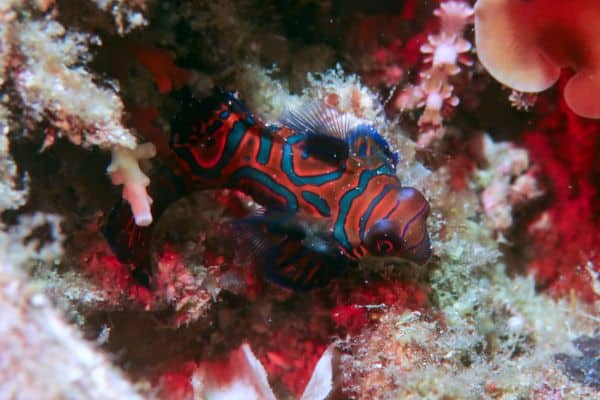
The Lighthouse is a dive site in Malapascua famous for spotting the elusive mandarin fish. Here you can find the shy dragonet known for their their psychedelic coloration and unique mating behavior. Malapascua is one of the few places in the world where you can observe these stunning fish, and dusk is the best time to do so.
As day turns into night, Lighthouse dive site transforms into a haven for nocturnal creatures. Under the guidance of your experienced DM, you will discover a whole new world of fascinating marine life.
Various cephalopods like reef squid, bobtail squid, starry night octopus, blue-ringed octopus, and cuttlefish have been sighted in this dive spot. Seahorses, crabs, shirimps, and sea stars, and sea slugs are a common sight here.
If you love night diving then you’ll love the light house too!
Scuba Dive in the Dark: What Is Night Diving Like?
If you’d like to learn more about marine life you might encounter in the Philippines, read these posts:
15 Dangerous Sea Creatures in the Philippines
Marine Life in the Philippines: 100 Sea Creatures You Must See
Malapascua Diving Conditions
Water Temperature
The water temperature in Malapascua ranges from 24 to 30 degrees Celsius (75.2 to 86 degrees Fahrenheit) throughout the year.
A 3mm wetsuit is recommended for most divers. Some divers may prefer a 5mm wetsuit for added warmth especially for night dives or early morning dives with thresher sharks. This is a matter of personal preference and tolerance for cold.
Visibility
The water visibility for Malapascua diving can vary depending on the season, weather conditions, and dive site. Generally, the visibility ranges from 10-30 meters (33-98 feet), with some sites offering up to 40 meters (131 feet) of visibility on a good day.
The best visibility is usually during the dry season, from November to May, when the water is calmer and clearer. However, even during the rainy season, from June to October, the visibility can still be good at certain sites.
Nitrox
It is recommended to dive with enriched air or nitrox in Malapascua. Diving depths can range from 18 meters to over 40 meters, and nitrox can increase bottom time and reduce the risk of decompression sickness. If you intend to dive with the threshers in Monad shoal, having your Nitrox certification will come in handy.
Nitrox is available at most dive centers on the island. If you are not yet certified for Nitrox, you can easily get certified with the PADI or SSI dive shops on Malapascua.
When is the best time to go to Malapascua Island?
The dry season or during the Amihan months, from December to May, is the greatest time to go diving in Malapascua. The waters are normally calmer and the visibility is better during this time. This creates optimal diving conditions and allows divers to completely appreciate Malapascua’s underwater splendor.
It is crucial to note, however, that Malapascua is a year-round diving destination, and diving may still be done from June to November. While visibility may be limited during this time, you can still see the incredible marine life that Malapascua has to offer.
It is worth noting that certain species like thresher sharks are frequently observed in the early morning hours, therefore dives should be planned accordingly.
Recommended reading:
Amihan and Habagat: Diving Seasons in the Philippines Explained
Best Time To Dive in the Philippines + Monthly Guide on Where to Go
Dive Shops in Malapascua
Malapascua island is home to several reputable dive shops.
Some of the popular dive centers in Malapascua:
Evolution
Thresher Shark Divers
Devocean
Sea Explorers
Malapascua Thresher Divers
These Malapascua dive centers provide a variety of dive courses, packages, and lodging alternatives to suit every budget and level of diving expertise. These diving shops are ideal for anyone wishing to discover the underwater world of Malapascua Island since they have competent and certified dive instructors, well-maintained dive gear, and a focus on customer satisfaction.
Liveaboards for Malapascua Diving
Malapascua Island is included in the dive itinerary of various liveaboard operators. These liveaboards often operate in the Visayas region, which includes dive destinations such as Apo Island, Dauin, Moalboal, and Bohol
For specific itineraries and dive spots, you can check the various liveaboard operators below:
1. M/Y Almaroon Intrepid – Philippines Aggressor
2. P/Y Atlantis Azores – Atlantis Dive Resorts Philippines
3. M/Y Infiniti- Infiniti Liveaboard Diving
4. S/Y Philippine Siren- Worldwide Dive & Sail Philippines, Inc.
5. M/Y Resolute – Far East Liveaboards Inc
6. M/V Solitude One – Nomadic Underwater and Tours
What to Pack for Malapascua Island Diving
Here is the scuba equipment and dive gear I brought when I went diving in Malapascua.
My Scuba Diving Gear
Regulator: Scubapro MK25 Evo, C300 and C200 2nd Stage
BCD: Aqualung Axiom
Mask: TUSA M-212 Freedom Ceos
Snorkel: TUSA SP-170 Platina Hyperdry II
Booties: Poseidon Pink Dive Boots
Fins: Problue
Wetsuit: Seavenger
Vest Hoodie: Scubapro Hybrid Hooded Vest
Dive Watch: Suunto D4i Novo
Dive Knife: Aqualung Blunt Tip Knife
Dive Leggings and Rash: Blue Adaptation Coral Sea Fan
My Underwater Camera Gear
Underwater Camera: Canon G7X Mark II
Underwater Camera Housing: Fantasea FG7XII
Video Lights: Big Blue AL1200XP
Underwater Action Camera: GoPro Hero9
360 Camera: Insta360 X3
> Canon G7X Mark II full review
> Insta360 X3 underwater camera review
> Scuba diving camera recommendations for beginners.
Dive Insurance
Divers Alert Network (DAN)


Need travel insurance for your trip? Get a quote from Safety Wing.
How to get to Gato Island
Here’s how to go to Malapascu Island.
- Fly into Mactan-Cebu International Airport, which serves various domestic and international carriers.
- Take a van or bus to Maya Port: From Cebu City, take a van or bus to Maya Port, which is located on the northernmost tip of Cebu island. Depending on traffic and road conditions, the trip takes about 3-4 hours.
- Take a boat to Malapascua Island: Once you are in Maya, take a short boat journey to Malapascua Island. Several boat companies provide regular services between Maya and Malapascua, with departures every 30 minutes to an hour. Depending on the sea conditions, the boat voyage takes from 30-45 minutes.
- Arrive in Malapascua: When you arrive in Malapascua Island, you can walk or ride a tricycle to your hotel or dive center.
For an additional price, some Malapascua dive operators and resorts may arrange private transfers from Cebu City or Mactan-Cebu International Airport. This can be a more handy and comfortable option, especially if you have a lot of luggage or want to avoid the inconvenience of public transportation. You can also check getTransfer.com if you prefer to travel in a private vehicle with a driver.
